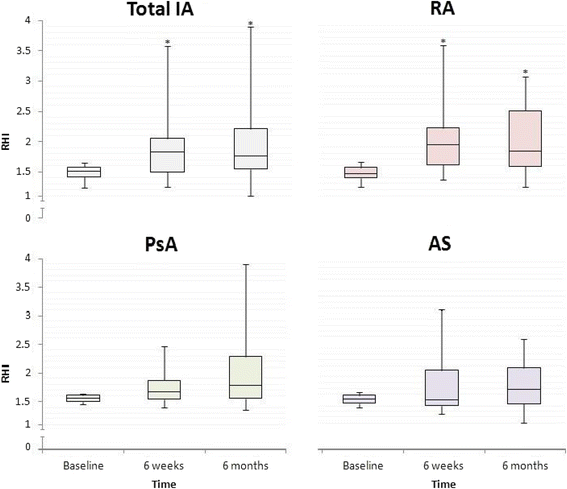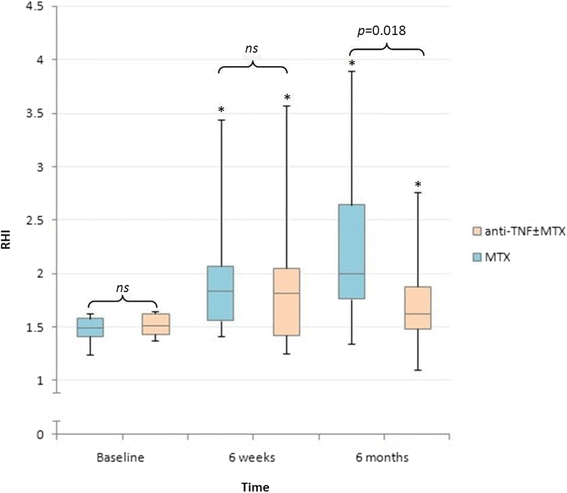Methotrexate and anti-tumor necrosis factor treatment improves endothelial function in patients with inflammatory arthritis
- PMID: 29041979
- PMCID: PMC5646156
- DOI: 10.1186/s13075-017-1439-1
Methotrexate and anti-tumor necrosis factor treatment improves endothelial function in patients with inflammatory arthritis
Abstract
Background: Inflammatory arthritis (IA), including rheumatoid arthritis (RA), ankylosing spondylitis (AS) and psoriatic arthritis (PsA), leads to increased cardiovascular disease occurrence probably due to atherosclerosis. One of the first stages in atherogenesis is endothelial dysfunction (ED). Therefore, we aimed to compare endothelial function (EF) in patients with IA, and to examine the effects of methotrexate (MTX) monotherapy and antitumor necrosis factor (anti-TNF) treatment with or without MTX comedication (anti-TNF ± MTX) on EF.
Methods: From the PSARA observational study, all patients with RA (n = 64), PsA (n = 29), and AS (n = 20) were evaluated for EF. In patients with ED at baseline (n = 40), we evaluated changes in the Reactive Hyperemic Index (RHI) after 6 weeks and 6 months of antirheumatic therapy.
Results: In IA patients with ED, RHI significantly improved after 6 weeks (p < 0.001) and 6 months (p < 0.001) of treatment, independent of changes in disease activity parameters. After 6 months, RHI had improved more in the MTX group than in the anti-TNF ± MTX group, and the difference remained statistically significant after adjustments for potential confounders. Among patients with active RA, AS, and PsA, those with AS appeared to have the worst endothelial function, although they were the youngest.
Conclusion: Treatment with MTX and anti-TNF ± MTX was associated with a relatively fast improvement of EF in IA patients with ED, independent of change in disease activity. Therefore, modes of action other than the anti-inflammatory effect may contribute to the EF improvement. After 6 months, the EF improvement was more pronounced in the MTX group than in the anti-TNF ± MTX group.
Trial registration: Clinicaltrials, NCT00902005 . Registered on 13 May 2009.
Keywords: Anti-tumor necrosis factor; Inflammatory arthritis; Methotrexate; Rheumatic arthritis; Spondyloarthritis.
Conflict of interest statement
Authors' information
Not applicable
Ethics approval and consent to participate
The Norwegian Regional Ethical Committee approved the study protocol and all patients gave informed written consent.
Consent for publication
All patients gave informed written consent to publish.
Competing interests
The authors declare that they have no competing interests.
Publisher’s Note
Springer Nature remains neutral with regard to jurisdictional claims in published maps and institutional affiliations.
Figures


References
-
- Han C, Robinson DW, Hackett MV, Paramore LC, Fraeman KH, Bala MV. Cardiovascular disease and risk factors in patients with rheumatoid arthritis, psoriatic arthritis, and ankylosing spondylitis. J Rheumatol. 2006;33(11):2167–72. - PubMed
Publication types
MeSH terms
Substances
Associated data
LinkOut - more resources
Full Text Sources
Other Literature Sources
Medical
Research Materials
Miscellaneous

